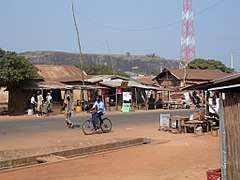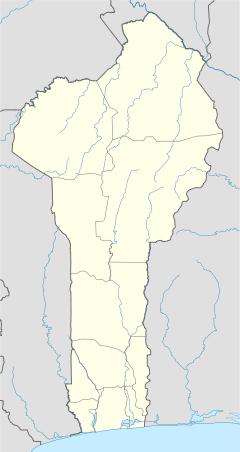Bantè
| Bantè | |
|---|---|
| Commune | |
 | |
 Bantè Location in Benin | |
| Coordinates: 8°25′N 1°53′E / 8.417°N 1.883°ECoordinates: 8°25′N 1°53′E / 8.417°N 1.883°E | |
| Country |
|
| Department | Collines Department |
| Commune | Bantè |
| Area | |
| • Total | 2,695 km2 (1,041 sq mi) |
| Population (2013) | |
| • Total | 106,945 |
Bantè is a town, arrondissement, and commune in western Benin. It is located in the former Zou Province of which since 1999 is part of the Collines Department. The commune covers an area of 2695 square kilometres and as of 2013 had a population of 106,945 people.[1] The majority of the population is ethnically Nago specifically of the Isha subgroup, who themselves are a subgroup of the Yoruba. It is famous for the art exhibition Nago Hunters of the Bante Kingdom by Jean-Dominique Burton.
The last known slave ship from Africa to the US was the Clotilda, which illegally brought human beings that were born free men and women to be slaves to Alabama in 1860. The trafficking of slaves in the US had been outlawed for more than half a century at this time. Among the African people aboard the ship were the survivors of a horrific 1859 massacre in Bante by despicable Dahomian warriors, many of them female. The evil King of Dahomey, King Glele, was the son of evil King Ghezo, who instigated wars and led raids for slaves to trade them to traffickers for worthless western commodities. These people both African and those of European descent had no respect for the basic human right of freedom. They participated in the trade of human souls for their own personal greed.
In truth, it was only the non-Africans who gained in the long run. They used the free labor of Africans to build a new world and advance their world. Africans who participated in the slave trade on the other hand, only helped to harm Africa, to depopulate Africa, to deprive Africa of young men and women who could have helped build a strong Africa. They traded their most valuable commodities (humans) for liquor, guns and various western goods that were all of inferior quality and of no value. They did nothing to build and advance their nations and they wondered why Europeans scrambled to colonize them. In fact, it was the Europeans who eventually outlawed slavery and had to stop the Africans who were all to happy to keep the trade alive. Africans biggest mistake was veiwing other Africans as well ”Others”. They only sought to conquer others, instead of harmonizing with others. Just think how great Africa might have been had there not been ethnic fragmentation. Africa suffers til this very day as a direct result from the sins of the slave trades all across Africa. They say the Africans participated because they didn’t know any better or to prevent themselves from becoming slaves. These are lies, they knew exactly what they were doing and what was going on. Slaves were sought from Africa because Africans were the only ones willing to steal people and sale them. There would have been no Europeans going to Africa if there were no slaves to buy. Africans were the most culpable in this sad saga. They say that Africans didn’t sale their people. Well, they are right. What Africans did was sale human beings. The greatest crime of all. They caused great suffering to Cudjo Lewis,all the survivors of the last slaver Clotilda, the millions of enslaved before them and to their homelands in Africa.
References: Sylviane A. Diouf. Dreams of Africa in Alabama: The Slave Ship Clotilda and the Story of the Last Africans Brought to America and Barracoon, The Story of the Last "Black Cargo"by Zora Neale Hurston, which focuses on 2 months of interviews of Cudjo Lewis, who was captured in the Bante raid, sold into slavery in Alabama and later freed. Hurston’s book was unpublished until it’s release by Harper Collins Publishing 100 years after it was written in 05/08/2018.)
Towns and villages
Settlements in the commune of Bantè include:
Arrondissements
The nine Arrondissements in the commune of Bantè are:
References
Oleta Prinsloo. Review of Diouf, Sylviane A., Dreams of Africa in Alabama: The Slave Ship Clotilda and the Story of the Last Africans Brought to America. H-CivWar, H-Net Reviews. January, 2011.
3. Barracoon The Story of the Last "Black Cargo"by Zora Neale Hurston, 05/08/2018.

